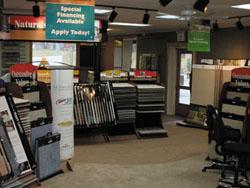Financial Services - May 2007
By Sonya Jennings
Are you thinking about offering financing to your customers? We spoke with several flooring dealers around the country with finance programs in place. Here’s what you need to know before launching a program of your own.
Go to a company like GE Money, CitiFinancial or Wells Fargo, which offer customer financing services for small retailers. The setup is simple, and the rewards can be lucrative.
According to Kathy Cutler of Cutler’s Carpet in Corning, New York, “Our customers are very comfortable using in-store financing to purchase large ticket items. They’ve become very familiar with these programs because of their presence in nearly every large retailer in the country.”
From purchasing furniture to flooring, spreading out payments with an interest-free program is incredibly popular.
Financing programs for small businesses are indistinguishable from the programs in national retail chains. The basic loan of 30, 60 or 90 days same as cash, and the even more popular programs such as 12 to 18 months interest-free financing, are very attractive to American consumers. “Offering financing to our customers is another way that our small, family owned business can compete with large national retail stores,” Cutler adds.
THE BENEFITS
• Increased cash flow: Aside from the relatively small fee the dealer pays to originate the loan, the full ticket price of a sale is deposited into the store’s bank account within a couple of days. At this point, the remaining payment is between the financing company and the customer. This greatly reduces the time and resources a store must dedicate to handling customer payments. “Cash is king,” says Gary Frankhouse, Jr. of Prints and Paints Floorcovering Company in Galion, Ohio. “The increased cash flow is one of the main reasons we use financing programs.”
• Customer trades up or buys more: Janet Gunderson, sales manager of Home Interiors Flooring and Design Centers in Wisconsin, says “The customer often trades up to a better product when financing is an option.” According to GE Money, when a customer pays with cash or check, the average sale is $750. When paying with a personal credit card, the average sale is $800. And when a store offers interest-free financing, the average sale skyrockets to $2,600. Because she doesn’t have to pay in full on the day of the purchase, a customer is more likely to trade up to higher quality products or complete two projects when she only planned on buying for one.
All of the dealers we interviewed agreed that the amount of money spent often goes up when financing is available.
• Customer loyalty: Janet Gunderson also believes that the customer is more loyal to her store for future purchases when he or she has already established in-store credit—just as a person might be more loyal to a particular department store if she has a credit card for that store.
THE CHALLENGES
• Handling denied credit situations: If a customer’s application for financing is denied, it can be a sticky situation for the store. The sales staff must be trained to handle the matter delicately.
• Communicating financing terms to staff and customers: Understanding the details of a promotion offered by a financing company is critical. For instance, there may be a short term offer for a longer finance period—let’s say 24 months rather than the usual 12 months. The exact start date, end date and terms of the promotion must be effectively communicated to the staff. Signage in the store should have up to date information. “Communication is the key,” says Gary Frankhouse. “Obviously, you do not want to offer your customer a promotion that ended yesterday, and this can happen if you are not careful about communicating the details to your staff.”
• Training sales staff: Training can also be a challenge. A couple of key points must be addressed with the sales staff. One, financing should be offered early in the sales process. According to Gunderson, “Offering financing at the end of the sale sends the wrong message to the client. It says ‘we know you can’t afford it, so how about financing.’ Presenting the program early lets the customer know that it is a standard part of the process.” Also, the term “financing” should be used instead of “credit.” The word “credit” implies interest charges and has an overall negative connotation. “Finance” is more palatable to consumers.
SETTING UP A PROGRAM
Many of the retailers we spoke with stressed the simplicity of getting started. The process takes 15 to 30 minutes. A small machine and terminal are sent to the store, and the set up is simple enough to be explained briefly on the phone with a finance company representative.
Training the sales staff is the next step. There are educational DVDs and materials available to assist owners in training their staff. This process takes approximately one to three hours.
Placing signage throughout the store is another way to promote the service and to remind the customer of the financing option while she shops. Frankhouse refers to the signage as his “silent salesperson.”
If you choose to initiate a financing program in your store, the keys to success are communication and training. In today’s culture, the ability to buy now and pay later is becoming more and more popular. Ultimately, giving the customer what he or she needs is always a safe bet.
Copyright 2007 Floor Focus
